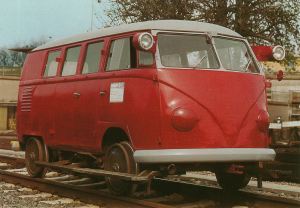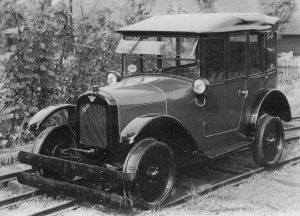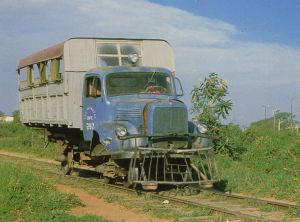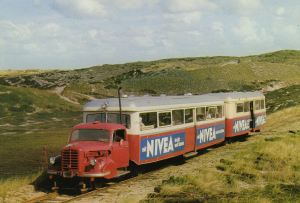‘The fray between tyre and train’
Imagine you’re the owner of a railroad probably a short line as they name it in the United States and dispatching cars like these on your network in case there’s low demand and still want to provide a certain service.
An original Volkswagen minibus on flanged wheels instead of rubber tyres. A lot of fun for the fans who’ll flock the premises and have a ride. Instead of catering the local needs in terms of transportation the venture becomes a touristic attraction but as long as you make some money no one cares.
The VW of this picture belongs to a heritage railroad located at Frankfurt am Main in Germany and still going strong as far as I know. Look what they did with the headlights; it gives a more mature appearance. This is an ex DB* railcar and mainly used for maintenance purpose, a perfect example of an era wherein vehicles of this kind in all sorts and shape could be seen on many places. A real automobile on steel wheels instead of their usual equipment for the road.
It was the French company Michelin famous for their tyres who begun building vehicles with a combination of the two; flanged wheels with a massif rubber layer, in one of my tales of China on this site; ‘A phoenix and the ashes’ some detailed pictures of this principle are shown. The industry experimented a lot but obviously it not developed into a widespread mode of transportation, it always worked in the shadow of what was constructed in the first place as a real rail bounded means of transport. They mainly for fill a duty in businesses aside or the more luxury vans as exclusive management transporter or way of inspecting the tracks. In history they left their mark but the signification rail and rubber still plays a role. The French have adopted it – better spoken prolonged – in their VAL system (Véhicule Automatique Léger) (automatic light vehicle) and also on the lines of the Parisian network ‘le train sur pneu’ (train on rubber wheels) transported thousands of people day in, day out. The tyres of these modes are filled with air and I am not a technician but the must have been made of an extremely good quality. Instead of rail some systems run in an art of concrete gutter others have a way beside the still existing rail and wheel with a flange to keep on course. What if by accident a nail would fall upon the surface where the wheels are running… a train with a flat tyre? I read and heard a lot about trains in my life but nothing similar alike. For a funny change the driver can call triple A road service. The pictures below give a small example of other types, a real Austin fit for the rail and even for a royal ride. The way the Bolivians have to endure any unevenness in the track. The famous Borgward with trailer on the German North Sea isle Sylt. Last but certainly not least a bus of the RTM (Rotterdam Tramway Company) a concept of the British firm Karrier from Huddersfield, the body however was built in the Netherlands at the works of Verheul and ran between Rotterdam and Oostvoorne where it left the track and hit the road for the last miles to the final destination Rockanje. O boy, it must have been a real joy!
* DB means Deutsche Bundesbahn – German Federal Railways. Before W.O.II it was called DRB Deutsche Reichsbahn – German State Railway. After the segregation in 1949 the name DR lived on in the German Democratic Republic, following the reunification it became DB again but this time meaning: Deutsche Bahn – German Railways.






Alles geabsorbeerd, mooi.
Mijn dank, doe ik het toch niet helemaal alleen voor mijzelf. De volgende bijdrage in deze serie ligt al klaar en gaat over de Alsthom locomotieven van de SRT.